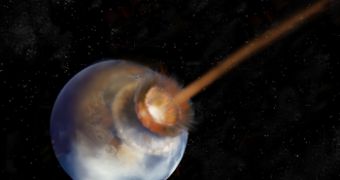Possibly, Drake's equation should also take into account the factor of comet activity in the environment of the planets that could actually support life. New statistics suggest that our own solar system is far more spared by such cosmic catastrophes than the similar nearby ones, so we own our very existence, to some extent, to celestial luck. This discovery is based on the telescope measurements on star dust performed by Jane Greaves from the University of St. Andrews in UK, with the help of the Spitzer Space Telescope.
Greaves combed through the data obtained by the Spitzer telescope for information related to the extent of comet activity in the nearby star systems, as compared to that within our own. This kind of measurements cannot be performed directly, since we still lack the necessary technology, but can instead be deduced from the generated radiation. When comets smash up on other celestial bodies, they produce impressive amounts of dust, which are heated by their stars and, as a result, emit infrared radiation.
This is detected by Earth-based telescopes, as it appears as extra radiation in the star's light spectrum. Since the dust dissipates at a fast pace, it provides a reliable way of determining the comet impact rate in the star systems closest to our own. The observations hinted to a much larger presence of such dust in most of the systems in our vicinity, which meant, from this point of view, that ours was among the very few that allowed for life to exist.
Based on Greave's research, it is safe to say that about 90% of the studied star systems are filled with dust to a much greater extent then ours is, which indicates that cosmic collisions occur far more often, lowering the possibility to expect life as we know it to exist there. However, while Mark Wyatt from the University of Cambridge admits to this, he also points out that the dust temperature level shown in the study indicates that the dust lies far from the central star, and so the collisions may not affect the possible habitable planets that should be located much closer to that respective star.

 14 DAY TRIAL //
14 DAY TRIAL //